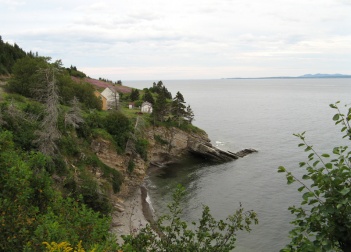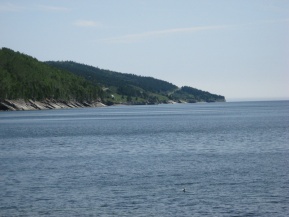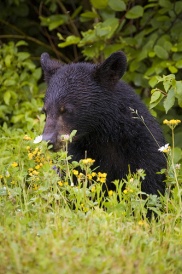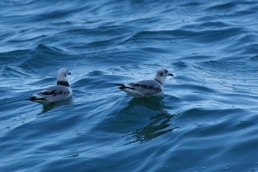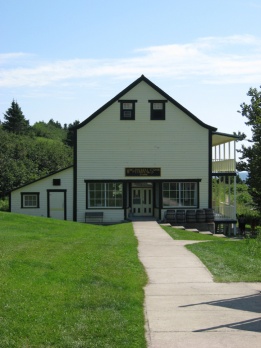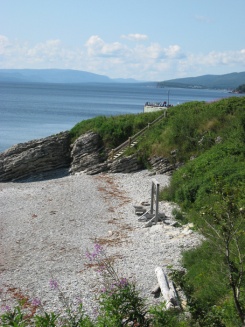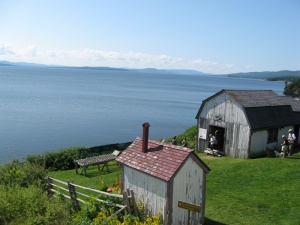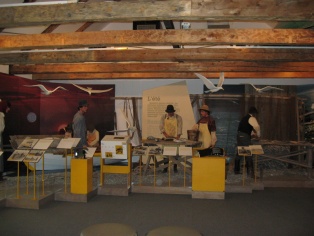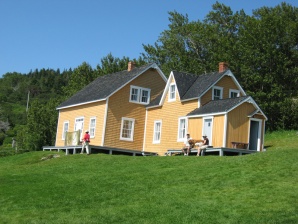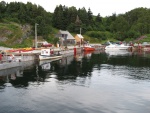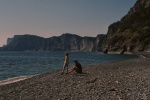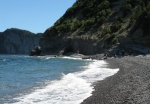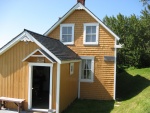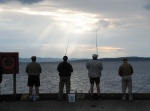Canada’s Forillon National Park
par Babin, Aryane
Located on the eastern tip of the Gaspé Peninsula, Forillon National Park is a Parks Canada site representative of the region's rich natural and cultural heritage. Here, land and sea meet to forge unique and spectacular landscapes. At Forillon, the sea's influence is everywhere, leaving its mark on the landscape, the shape of the coastline, the temperateness of the climate, which supports abundant marine life and serves as a constant reminder of what first drew people to the area. The park's unique natural environment is home to more than ten distinct geological formations, as well as several large seabird colonies. The area also has a fascinating history. The first Europeans settled along the rugged coast in the 18th century, near the small coves that were well suited to fishing. The park was established in 1970 to protect and promote this rich heritage. Its creation was however marred by controversy, as local residents were force to move off their lands, in order to make way for an idealized pristine wilderness.
Article disponible en français : Parc national du Canada Forillon
Unique Natural Beauty
Forillon National Park is known for the diversity of its natural riches. The park's main attractions are its remarkable geological features, notably the rugged coastline forged by thousands of years of marine erosion. From a geological standpoint, the tip of Forillon Peninsula is an ideal location to sight ancient formations of the Ordovician and Siluro-Devonian periods.(NOTE 1) Readily visible to park visitors, these unusual formations, with their different colours, shapes and textures, are a visual record of the movements of the earth's crust that spawned the Appalachian Mountains.
Forillon is also remarkable for its diverse plant life, with ten separate ecosystems within its boundaries. The largest of these is the forested zone, which covers 95% of the park. This lush environment is greatly influenced by the maritime climate of the Gulf of St. Lawrence, which surrounds the peninsula. On the south side of the park, the forest is interspersed with abandoned fields once farmed by former residents. In Gaspé Bay, fresh and saltwater intermingle, while at Penouille, salt marshes dominate the landscape. The cliffs stretching to the point at Cap-Gaspé host numerous seabird colonies and clusters of rare plants. Indeed, the park is home to a wide variety of plant species, in spite of its relatively small land area. Altogether, some 700 species have been identified, of which 80% are specifically adapted to a particular habitat. For example, arctic-alpine plants, lingering vestiges from the last ice age, are found on several high cliff tops. There is also a special sort of sea-level taiga, an ecosystem normally found at higher altitudes or latitudes. The conditions at Forillon (sand, poor soil and climate) seem to have created a habitat suited to this type of vegetation. Together, these unusual combinations of vegetation account for the unique features of Forillon's various ecosystems.(NOTE 2)
With the ocean on its doorstep, Forillon is also home to an abundant and diverse array of birdlife. Approximately 225 bird species, including 124 nesting varieties that congregate in colonies along the sheer cliffs, wide beaches, as well as elsewhere in the park. Every year, spring migration marks the return of birds, drawn by the nesting sites and the abundant food supplies in the waters of the Gulf of St. Lawerence and Gaspé Bay. Among them are numerous seabirds, including the Double Crested Cormorants and Black Guillemots that perch on the cliffs at Cap Bon Ami and the Great Blue Herons that fish the Penouille marshes. Park fields and forests also attract many small terrestrial birds, as well as 26 species of birds of prey. The sea, the predominant influencing factor in Forillon's environment, leaves its own special mark on the landscape, shaping the coastline, tempering the climate, supporting abundant marine life and serving as a constant reminder of what first drew people to the area.(NOTE 3)
Forillon's
Historic Heritage
Forillon's cultural heritage is particularly rich as a result of its long history of human habitation. Archaeological excavations have found traces of human occupancy dating back some 9,000 years(NOTE 4), notably at Penouille. In the 18th century, European fishermen began to frequent the area on a seasonal basis. Attracted by the peninsula's geographic location and its rich marine resources, they then began to settle permanently. The earliest villages were established along the coves, bays and coastal lagoons of Chaleur Bay, in order to take advantage of the many beaches, which were particularly ideal for preparing and drying cod. Later arrivals settled on the gulf side of the coast all the way to the northern part of the Gaspé Peninsula. They, however, had to adapt to Forillon's rugged coastline.
Between 1770 and 1800, despite the Conquest and the transition to the British regime and the resulting upheaval in the Gaspé settlements, a distinct form of social organization developed around the fishing industry and the cod trade. Motivated in part by the British government's desire to promote permanent settlement, but also by the rising prosperity of the fishing companies, settlers began to migrate into the area anew. At Forillon, as in the rest of the Gaspé Peninsula, Channel Island fishing companies controlled primarily by merchants from Jersey and Guernsey established a virtual monopoly over the cod fishing industry. Operating on a model of economic dependency(NOTE 5), these companies and their owners wielded immense financial and social power from the end of the 18th century right up until the beginning of the 20th century. The main reason this system remained in place so long was the region's isolation from major centres and the specialized nature of the cod fishery. Over the years, the Forillon area was dominated and defined by this system.
Throughout this same period, the early inhabitants showed courage and determination in settling in Forillon. Faced with a rugged and difficult environment characterized by isolation and a harsh climate, they had no choice but to learn the skills they needed to eke out a subsistence living. Although long winters and often impassable roads left Forillon's communities in near complete isolation, families and neighbours developed strong social bonds, especially in the summer months, when everyone pitched in to preserve the cod the fishermen brought home. The fish was dressed, salted, and dried in the coves dotting the coastline. Beach access was often treacherous because of the steep cliffs atop which homes were built. To make it easier, fishermen would build ladders and staircases equipped with hoists to drop fishing gear to the beaches, haul up the boats and bring in the day's catch. Fishermen led a strenuous existence and generally had to work at other jobs to meet the needs of their families. This is why so many also turned to subsistence farming and logging. However, fishing continued to be the lifeblood of the coastal communities.
Despite the toil and the heavy regulation of the industry imposed by the fishing companies, Forillon's residents were attached to their livelihood and remained convinced that fishing was the most profitable and stable occupation available to them. It was a way of life that demanded a host of practical skills (net-making, boatbuilding, farming, etc.), all handed down from generation to generation. At Forillon, the tasks that were necessary to ensure each family's livelihood were closely linked to the seasons and the available natural resources.
Establishing
Forillon as a Heritage Site
Forillon, with its rich natural and cultural heritage, was officially established as a conservation area in 1970, when the national park was created by the federal government in cooperation with the Quebec government. Up until then, Forillon's residents had gone about their day-to-day business without a thought to the future of the region, but then, in order to ensure conservation and restore the new park to a natural wilderness state, their land was seized by the Quebec government and transferred to the federal government. Furthermore, under the National Parks Act,(NOTE 6) commercial activities were no longer allowed within park boundaries. The goal of Parks Canada is "to protect for all time representative natural areas of Canadian significance in a system of national parks, and to encourage public understanding, appreciation and enjoyment of this natural heritage so as to leave it unimpaired for future generations."(NOTE 7) Not surprisingly, the wholesale seizure of 225 family lots sparked controversy in the region. The compensation offered was deemed insufficient and decisions regarding the way the expropriations were carried out were contested in court by some of the families involved, who later eventually won their cases in 1975. Even today, tensions about the land seizures linger on in the region.(NOTE 8)
Since the park's inception, various programs have been established by Parks Canada to preserve and promote Forillon's natural and cultural heritage. For example, one conservation program focuses on factors that could threaten the park's ecological integrity. Despite Forillon's protected status, its ecosystems are not immune to the impact of human activity in the neighbouring villages. To remedy this situation, Parks Canada has established special protection corridors along the main road to ensure that animals can travel unhindered to and from the park, in order to allow them circulate freely in the region, thereby avoiding species isolation.
An interpretation program running from late May to mid-September introduces visitors to the park's natural heritage. Guided and non-guided hikes are available as well. Park users can also visit the Penouille sector, a popular viewpoint and beach area accessible by electric shuttle. This unique site is home to salt marshes, artefacts and vestiges of whale hunting. An on-site naturalist informs and educates visitors about the point's natural features, as well as of their significance and fragility.
Although natural heritage protection has always been Parks Canada's main goal, Forillon's cultural history has also been incorporated into the park's interpretation program at several sites: Anse-Blanchette, Grande-Grave, St. Peter's Church, and the Hyman Store. At Grande-Grave, the buildings, untended fields and harbour provide a glimpse of local 19th and 20th century architecture-with the wooden homes looking out onto Gaspé Bay-as well as with an opportunity to understand the lifestyle of the former residents. The Hyman & Son General Store is stocked with goods from a bygone era and illustrates the barter and credit system put in place by the Channel Island fishing companies. A visit to the store shows the central role cod fishing once played in people's lives. On the second floor, an exhibit presents the climatic cycle of the seasons: winter was long and harsh; spring was a time of renewal when everyone prepared for the fishing season and sowed a new crop of vegetables; summer was very busy with fishing, maintaining gear and tending the garden; and fall was the time to bring in the harvest, stock up on provisions and cut firewood for the long winter ahead.
Cultural heritage presentation initiatives at Forillon continue today, as Parks Canada pursues plans to focus more on the families who were living within current park boundaries at the time of the land expropriation. The period covered by the existing cultural interpretation program ends in 1942 (years before the land seizures). Parks Canada and various contributors are currently developing plans for an exhibit that will present a socioeconomic portrait of Forillon's residents prior to and at the time of the land seizures. An unoccupied house within the park will be used for this purpose.
Developing
Heritage Conservation at Forillon
Despite the events that surrounded the establishment of the park, the people of the region were quick to recognize the significance of Forillon's natural and cultural heritage and the need to protect it. Everyone agreed on the importance of preserving and showcasing the park's mountainous landscapes and rich history, which, over time, have become so closely associated with the region's identity. In addition, as it receives 175,000 visitors annually, Forillon has become a major tourist attraction that has helped the Town of Gaspé and the Gaspé Peninsula to become national and international tourist destinations.
This growing recognition, coupled with the regional population's increased interest in local heritage and the recent initiative acknowledging the evicted former park residents, has enhanced the park's reputation. Moreover, given the increasing popularity of ecotourism, Forillon's popularity as a destination is only likely to grow, largely due to its breathtakingly beautiful landscapes and the many activities that allow visitors to discover its rugged splendour-activities such as hiking, horseback riding, sea kayaking, sunbathing, or swimming at the many beaches. Thus the rich natural and historic heritage of Forillon National Park leaves an indelible impression upon all who experience it.
Aryane
Babin
Master's Student in History, Laval University
NOTES
Note 1: The two respective types of geological formations between 500 and 400 million years of evolution, which makes Forillon an ideal site for geological study.
Note 2: Beauchemin, Op. cit., p. 46.
Note 3: Ibid, p. 5
Note 4: "Illustrating the Harmony Between Man, the Land, and the Sea," Parks Canada, retrieved 09/11/17 [online] http://www.pc.gc.ca/eng/pn-np/qc/forillon/natcul/natcul1.aspx
Note 5: This economic system relied on the fishermen obtaining goods and fishing gear from the companies for credit in exchange for the cod they would produce. It was a barter system that plunged the cash-strapped fishermen into debt and left them dependent on the companies.
Note 6: National Parks Act, R.S.C 1985, c. 189, part. I, art. 6 no. 1
Note 7: Maxime St-Amour. Forillon National Park: the harmony between man, the land, and the sea: a guide Douglas & McIntyre in association with Parks Canada, 1985, p. 8
Note 8: Philippe Daoust, « Un comité provisoire d'expropriés s'organise à Forillon », Le Pharillon, 16 décembre 2009
BIBLIOGRAPHY
Beauchemin, Paul T. Forillon, Montréal, Beauchemin, Beaton et Lapointe, 1971, 63 pages.
Bourdages, Jean-Luc, Bourchard, André et Marie-Odile Trépanier. Les parcs naturels du Canada et du Québec : politiques, lois et règlements, Montréal, Université de Montréal, 1984, 123 pages.
Comeau, Denis, Sigouin, Daniel et Hervé Pelltier. Énoncé sur l'intégrité écologique, Parc national du Canada de Forillon, Services de la conservation des ressources naturelles, 2000, 12 pages.
Daoust, Philippe. « Un comité provisoire d'expropriés s'organise à Forillon », Le Pharillon, 16 décembre 2009.
Desjardins, Marc, Frenette Yves, Bélanger, Jules et Bernard Hétu. Histoire de la Gaspésie, Québec, Institut québécoise de la recherche sur la culture, 1999 (1981), 795 pages.
Lothian, W.F. Petite histoire des parcs nationaux du Canada, Ottawa, Environnement Canada, 1987, 166 pages.
Parcs Canada. Ensemble culturel Grande-Grave : programme de réalisation, Ottawa, Parcs Canada, 1980, 227 pages.
Parcs Canada. Stratégie d'interprétation du Parc National Forillon, Ottawa, Parcs Canada, 1982, 35 pages.
Parcs Canada. Plan de conservation : parc national Forillon, Région du Québec, Services de la conservation des ressources naturelles, 1995, 88 pages.
Parcs Canada. Parc national du Canada Forillon : document d'information publique, Ottawa, Parcs Canada, 2003, 25 pages.
St-Amour, Maxime. Guide du Parc National Forillon : l'harmonie entre l'homme, la terre et la mer, Ottawa, Centre d'édition du gouvernement du Canada, 1984, 127 pages.
Ward, Neville E. et Beth Killham. La conservation du patrimoine en milieu naturel, Centre des ressources du patrimoine, Université de Waterloo, 1987, 198 pages.
« La vraie nature de Forillon », Parcs Canada, site consulté le 17/11/09 [En ligne] http://www.pc.gc.ca/pn-np/qc/forillon/natcul/natcul1_F.asp
Additional DocumentsSome documents require an additional plugin to be consulted
Images
-
 Paysage estival à Pen
Paysage estival à Pen
ouille -
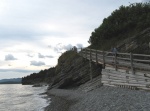 Rampe d'accès des pêc
Rampe d'accès des pêc
heurs à la plag... -
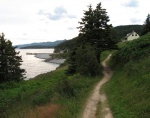 Sentier pédestre, riv
Sentier pédestre, riv
e sud -
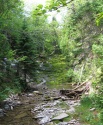 Sentier près d'un rui
Sentier près d'un rui
sseau

